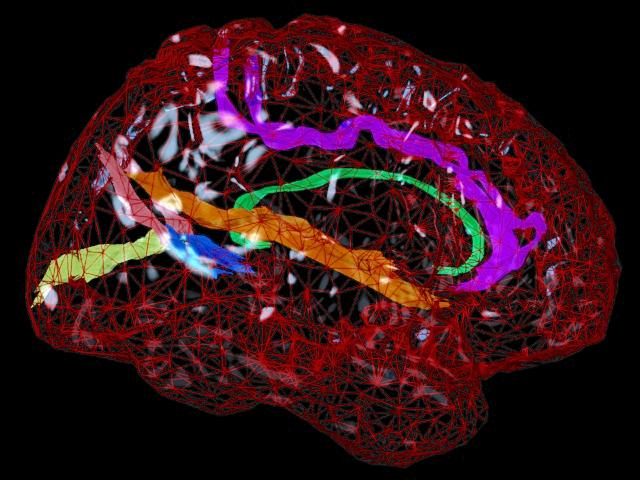
Paul M. Thompson and Arthur W. Toga
Laboratory of Neuro Imaging, Department of Neurology, Division of Brain Mapping, UCLA School of Medicine, Los Angeles, California 90095
This paper describes the design, implementation and preliminary results of a technique for creating a comprehensive probabilistic atlas of the human brain based on high-dimensional vector field transformations. The goal of the atlas is to detect and quantify distributed patterns of deviation from normal anatomy, in a 3D brain image from any given subject. The algorithm analyzes a reference population of normal scans, and automatically generates color-coded probability maps of the anatomy of new subjects. Given a 3D brain image of a new subject, the algorithm calculates a set of high-dimensional volumetric maps (typically with 384x384x256 ~ 0.1 billion degrees of freedom) elastically deforming this scan into structural correspondence with other scans, selected one by one from an anatomic image database. The family of volumetric warps so constructed encodes statistical properties and directional biases of local anatomical variation throughout the architecture of the brain. A probability space of random transformations, based on the theory of anisotropic Gaussian random fields, is then developed to reflect the observed variability in stereotaxic space of the points whose correspondences are found by the warping algorithm. A complete system of 384x384x256 probability density functions is computed, yielding confidence limits in stereotaxic space for the location of every point represented in the 3D image lattice of the new subject's brain. Color-coded probability maps are generated, densely-defined throughout the anatomy of the new subject. These indicate locally the probability of each anatomic point being as unusually situated, given the distributions of corresponding points in the scans of normal subjects. 3D MRI and high-resolution cryosection volumes are analyzed, from subjects with metastatic tumors and Alzheimer's disease.
Gradual variations and continuous deformations of the underlying anatomy are simulated, and their dynamic effects on regional probability maps are animated in video format, on the accompanying CD-ROM (this volume). Applications of the deformable probabilistic atlas include the transfer of multi-subject 3D functional, vascular and histologic maps onto a single anatomic template, the mapping of 3D atlases onto the scans of new subjects, and the rapid detection, quantification and mapping of local shape changes in 3D medical images in disease, and during normal or abnormal growth and development.
Key words: brain mapping, probabilistic atlas, non-linear image registration, 3D stereotaxic space, morphometry
Running title (40 characters): A Probabilistic Deformable Brain Atlas
Paul Thompson
| RESUME| E-MAIL ME| PERSONAL HOMEPAGE| PROJECTS |
|---|